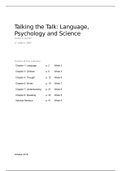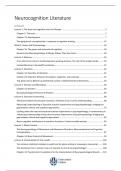Talking the Talk: Language,
Psychology and Science
Trevor A. Harley
1 s t edition: 2009
Content of this summary:
Chapter 1: Language p. 2 Week 2
Chapter 3: Children p. 6 Week 3
Chapter 4: Thought p. 12 Week 8
Chapter 6: Words p. 19 Week 7
Chapter 7: Understanding p. 27 Week 6
Chapter 8: Speaking p. 33 Week 5
Aphasia literatuur p. 41 Week 4
October 2018
, Chapter 1: Language
Language = primarily a system for intended communication, a system of words and rules
(syntactic rules – syntax) for combining them. Also the relation between the meaning and
appearance/sound of words is arbitrary (niet vasttaand).
How do languages differ?
Inflection is a grammatical change to a verb or a noun. For example: you change the tense
of a sentence, and the verb changes (walk/walked; -ed is added). Or: you change the
number in a sentence which changes the noun (mouse/mice or –s is added).
All languages differ in words, syntactic rules, inflection to mark grammar and more.
What are the issues in psycholinguistics?
Four controversies:
1. Is our language behaviour ruled by using grammar rules or by language experience?
2. Does knowledge come from nature or is it learned (nurture)?
Nativism view says we are born with particular information
Empiricist view says we are born as an ‘empty canvas’ and learn from experience
3. Is processing modular or interactive? So do little modules have their own isolated
task in your head or do different processes interact in your head?
4. Is the knowledge and process of producing/understanding language specific to
language or general-purpose?
Important terms from this chapter:
Linguistics = The study of language (structure, biological aspects, rules, history)
Psycholinguistics = The study of the psychology of language, not about how we use language or the
psychology of communication, but it is a science of what we know when we know language, and how
we implement this unconscious knowledge in real time.
Neuropsychology = The biological aspects of psychology, research concerning which parts of the
brains correlate to which behaviour
Communication = Intentionally conveying information from one person to another
Language = A communication system with rules and structure
Speech = The production of (“logical”) sounds
Syntax = The rules of word order of a language
Lexicon = Our mental dictionary
Case (naamval) = Marks the grammatical role of a category
Inflection = A grammatical change to a verb or a noun
Pro-Indo-European = The language from which most European and West Asian languages derive
Language evolution = How language first arised and developed
Broca’s area = The part of the brain where speech is produced
Wernicke’s area = The part of the brain where you comprehend language
FOXP2 = The gene that’s necessary to acquire, produce and understand language
Nativism vs empiricism = we are born with certain language knowledge vs. we learn language from
experience
Modularity vs interactivity = different modules in the brain have different tasks vs. different modules
are connected, interact and do not have separate tasks
2
,Pragmatics vs semantics:
pragmatics = the aspects of meaning that do not affect the literal truth of what is being said; these
concern things such as choice from words with the same meaning, implications in conversation, and
maintaining coherence in conversation.
semantics = the study of meaning in language (relationship between signifiers - words, phrases, signs,
symbols - and what they stand for)
Discussion questions:
1. Does language also have other functions than communication?
Language can be used to convey emotion and to make a group of people feel connected (because
they speak the same language).
2. Is ‘language’ the same as ‘speech’?
You could argue that this is not the same, since a parrot for example can speak some sentences he’s
learned, but only repeats what he has been taught and does not actually speak the language.
3. What’s the ‘big power’ of human language (compared to communication systems that animals
have)?
Humans are able to talk about future and past tenses and have more ability to express themselves,
reaching further than just the primary needs like food, mating and surviving.
4. You can define a word as a connection between a shape and a meaning. What’s an essential
characteristic from this connection?
The fact that this is is something we as humans came up with. For example we say the symbols that
form the word ‘tree’ have the meaning of the big green thing outside, because this is something we
agree on – a rule we made up ourselves.
5. When did language ability arise in the evolution of humans? Which evidence do we have for
that?
Research shows that Neanderthals (who lived over 30.000 years ago) possessed a version of the
FOXP2 gene that plays a significant role in language. Also, a bone was found that supports the base
of the tongue, suggesting that they were more able to speech than originally thought.
6. Why are sign languages perceived as natural languages? And why do you think some people are
against this statement?
People see sign language as a natural language, because it occurs in the same way as spoken
language and has the same structure. However, some people do not see sign language as a natural
language, because there is no speech involved (?).
7. Language are born and die out. Under what circumstances can you predict with certainty that a
language will die out?
If the language does not have a written form and the speakers form a small group that not growing
and is isolated from other people outside the group who could possibly learn the language.
Lecture 1 notes:
Since the Chomskian revolution in the 1950s, linguistics is seen as a part of cognitive science.
Cognitive science was a counter theory for behaviourism. Behaviorists reject the study of the human
mind as something scientifically possible and their goal is solely to come up with a theory of how a
certain behavior is determined by certain external stimuli. Cognitivists however, want to understand
the underlying mental processes.
The brain actively contributes and interprets what is perceived – in language; from sound to
meaning. It’s important to know that cognition is active in the mind.
3
, Modularity = idea that different modules in the brain have different tasks. The McGurk effect is an
example of this idea.
Another important thing: We need to distinguish between language as a cultural/social phenomenon
and language as a biological phenomenon.
Cultural/social aspect: language use
Biological aspect: knowledge of language
Now what is the relationship between mind and brain?
Of course the brain is physical and the mind cannot be seen or touched. The Computational Theory
of Mind compares brain and mind with hardware and software. To know something means to have
the necessary hardware (brain) that is capable of running a specific program (software mind).
Software without hardware is useless, and the other way around, so the brain and the mind need
each other.
There are three levels of understanding:
1. Computations = operations can we performed independently of context (e.g. the principle of
3y+2y=5y and 2w+3w= also 5w). You understand the structure and can apply this knowledge in
different situations.
2. Algorithm = how the computation is carried out what the computer (brain) is programmed to
do.
3. Implementation = what the software is prepared to do by what means is something done?
So for example in language research:
• WHAT (computations):
theoretical linguistics
• HOW (algorithm):
what happens in real time processing
• By What Means (Implementation):
Patterns of neural activation?
Relevant brain structures
A still unanswered question is how these three levels relate
Phonology: the unit of analysis is a phoneme. It’s the first purely linguistic, meaningful level and
exists of the most elementary units of speech. Phonemes are organized in a structure and there are
constraints on possible and impossible structures (computations). For example: there is no word in
English that starts with /rt/.
Morphology: a morpheme is the smallest meaningful unit of speech. (E.g. Cat – cats, the s is a
morpheme that gives new meaning to the word).
Morpheme vs phoneme: Morpheme is smallest unit of meaning (s is sound but can also change
meaning) (-able/-ing are also examples of morphemes).
Phoneme just smallest unit of sound, it can also be a morpheme, some sounds do change meaning
and some sounds don’t (depending on the language).
Syntax: the unit of analysis is a phrase. Phrases are organized hierarchically and rules of syntactic
computations are followed unconsciously by native speaker
4







